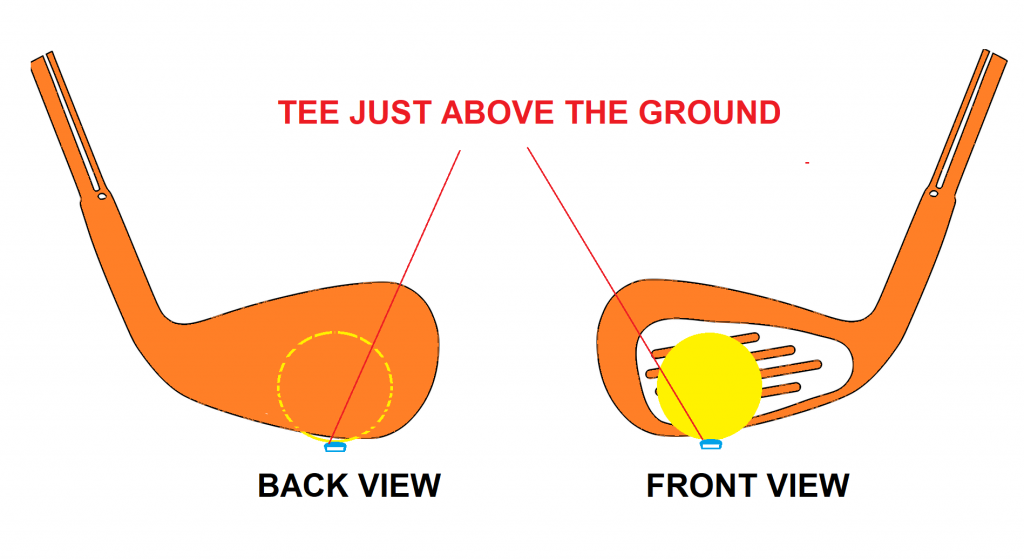How High to Tee a Golf Ball
This article is more than 2 years old
If you are a beginner you must have thought about how high to tee a golf ball for iron or a driver. It can be pretty intimidating initially because it makes the game feels a bit complex. My focus is to explain the teeing process backed with science and logic. If you get the concept clear in your mind once you will not have trouble adjusting tee height for any shot. This post focuses on the golf tee height guide. By the end of this post, if read carefully you should have the theory behind teeing cleared.
WHY DO WE TEE A GOLF BALL
Before you tee a ball the main question is why tee a golf ball at all. Why can’t we play a shot without teeing it for the driver or iron shots? The answer is situation requires the ball to travel long distance and elevation is not possible without teeing the ball. PGA has set guidelines for how the golf ball should be made. Because of certain design limitations, the golf ball cannot be made beyond a certain mass limit. This restricts the maximum distance golf balls can go. Therefore, companies are researching a lot to bring up the best balls that can perform maximum under the limitations.
So with a ball designed to travel long distance under design restrictions and if you hit it with a driver without tee then loft angle for maximum distance cannot be achieved. It is not possible to get maximum distance potential from a golf ball without having it on a tee. Consider it by yourself, while swinging the driver or iron it is necessary to make sure that at the time of impact the club face should be looking up. If the clubface is looking down or is parallel to grown then what is the difference between a putt and a driver shot?
So the short explanation is: a good launch shot needs an appropriate launch or loft angle. Without tee it is not possible to achieve a loft angle that can optimize the maximum distance with the swing speed. The purpose of tee is like to suspend the ball in the air and hit it as firm as possible into the air with no energy lost by impact with the ground.
How High To Tee A Golf Ball For Driver
A typical driver face has no loft angle on it. they are usually curved from edges and more flat from the center. From the design perspective that is to ensure that the ball gets smashed right from the center of the face and golf ball can travel the maximum distance.
If the ball was laying on the ground then smashing it will surely hit it in the center but it will not gain any height. Drive shot requires the most power and at high speed, it gets almost impossible to launch the ball at the desired angle. If this ball could be suspended in the air then it would be easy to hit this ball in the air with the same full face impact. This suspension is done via Tee. Maybe in future, they can air hose pushing the ball up for suspension but today Tees are the only option.
So how high should be a tee for driver shot? The answer is half the ball should be above the driver’s face when you place both of them side by side. Like this figure:

I have tried to illustrate in the picture what size tee for the driver is optimum. Place the ball on the tee, get into your shot stance position and make sure that if you look the driver from the back, half of the ball should only be visible (left picture). This half ball visible shows the right height to achieve the best loft angle, ball speed and hence the distance.
How High To Tee A Golf Ball For Iron
For iron it is a lot different than a driver. Iron faces are designed at a certain loft angle. Driver faces are flat but irons are already chiseled at a specific angle. It means that they have the launch angle pre-built in them. This implies that we do not need to suspend the ball up high in the air. So the tee length has to be short. How short it should be that is the main question.
The ideal length for iron is slightly above the ground. If the tee length is longer then you will not be able to hit the ball firmly into the air. There is a great chance that the center will not be in complete contact the face of the iron. The result is low ball speed and less distance traveled.

The blue part represents the Tee. It is just above the grass or an analogy of two placing the ball above two nickels. This combination offers the maximum ball speed. If tee length is made any longer than this short one than because of natural loft angle of the iron the impact of ball and iron face will not be strong.
Lesser energy will be transferred on the ball because ball will not be hit at the center but rather below the center that increase the loft angle more than the required and reduces the distance traveled.



